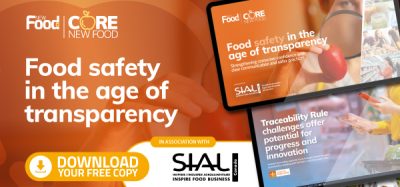Lies, damn lies and clean labels
- Like
- Digg
- Del
- Tumblr
- VKontakte
- Buffer
- Love This
- Odnoklassniki
- Meneame
- Blogger
- Amazon
- Yahoo Mail
- Gmail
- AOL
- Newsvine
- HackerNews
- Evernote
- MySpace
- Mail.ru
- Viadeo
- Line
- Comments
- Yummly
- SMS
- Viber
- Telegram
- Subscribe
- Skype
- Facebook Messenger
- Kakao
- LiveJournal
- Yammer
- Edgar
- Fintel
- Mix
- Instapaper
- Copy Link
Posted: 22 February 2016 | David Taylor, Senior Scientist, NoWFOOD Research Development Centre, University of Chester | No comments yet
Food fads are nothing new and the latest one is the rise of the minimally processed, free from additives, clean label food. Consumers are looking more and more at ingredients lists to decide if that product is something they want to eat. The problem is, are the claims misleading and does the consumer know what they mean anyway?


Whenever anyone of us sets foot inside a supermarket we are subjected to some of the most compelling psychological techniques known to marketing. Over many years the supermarkets, along with the food manufacturers whose products fill their shelves, have developed and fine tuned store layout, product placement and package design to the minutest detail in order to entice the consumer and maximise sales1.
Some of the techniques employed are fairly obvious and, by now, well known to the customer. For instance we will all recognise the general layout of the aisles as they are more or less the same in every store you enter. You are immediately met with beautifully coloured fruit, next to the pre-packed sandwiches and fizzy drinks – perfectly placed for people who pop in to grab lunch. For staple foods like bread and popular products like alcohol you will have to walk to the far end of the store and pass all the special offers and cooking smells like rotisserie chickens – they hope you will feel hungry and buy something you did not intend to.
Other techniques employed are not so obvious but nonetheless scientifically deadly. For instance, Cornell Food and Brand Lab Researchers Aner Tal and Brian Wansink recognised that eye contact increases brand trust, so are you aware that the eyes on the faces of the cartoon characters on children’s cereal boxes look down at an angle of 9.76 degrees so they look directly at small children, while the faces on cereal boxes designed for adults look straight ahead2 . The height they are placed on the shelves means they make eye contact with their target consumer.
This is clever stuff, and of course it is perfectly legal, after all the consumer is not being misled, just willingly guided! However, other techniques have, and are being employed where it could be argued that regulations are being stretched and the consumer deceived. Do you remember a juice drink called ‘Sunny Delight’? It was a marketing success story of the 1990s and early 2000s3 . Children loved it and mums did not mind as it was a healthy orange juice drink – it must have been, after all it was placed in the chilled display unit with the other fresh juices. Not so, it was an entirely processed product full of colourings, flavouring, added sugar and thickener. Questions were asked of the director of the Asda brand, Penny Coates at the House of Commons Select Committee on Health about its positioning with other fruit juices to give an impression of it being healthy, which she conceded did not help4 . Soon after this, combined with a story of a young girl turning orange after drinking too much, sales slumped.
The current trend in supposedly healthy food is the ‘clean label’ denoting a ‘natural’ product which has had minimal or no processing although there is no accepted definition. Of course, claims made on labels are subject to regulation and false or misleading claims may lead to legal action against manufacturers. Once again, this is nothing new, in fact there have been prosecutions on just this point. As far back as 1983 Britvic Ltd were charged that they falsely described their product, a combination of orange juice, concentrated orange juice and water as ‘natural’ contravening regulation 6(f) of the then Food Labelling Regulations 19845. On appeal in the High Court, Counsel for the appellant referred to the much older case of Davenport v Apollinaris Co Ltd (1903) regarding the description of mineral water with added carbonic acid as ‘natural mineral water’. Both of these cases demonstrate that manufacturers have for many years known of the benefit of describing their products as ‘natural’ even where it is contentious.
In the European case of D’arbo it was the opinion of Advocate General Léger in the European Court of Justice that strawberry jam manufactured by an Austrian company could not label its product as ‘naturally pure’ considering that it contained pectin gelling agent and traces of lead, cadmium and pesticides (albeit at safe levels)6. Mr Léger decided that this reference was liable to mislead the consumer as to the characteristics of the foodstuff within the meaning of Article 2(1)(a)(i) of Directive 79/112. He also cited the judgment in Gut Springenheide and Tusky (1998) in deciding if a statement is likely to mislead, the national courts must take into account “the presumed expectations of an average consumer who is reasonably well informed and reasonably observant and circumspect”.
Since these cases were decided, much of the law (although not all) concerning labels and claims made about food has been revised. The relevant legislation on the matter is now found in several sources. Article 16 of Regulation (EC) 178/2002 laying down the general principles and requirements of food law, requires labelling, advertising and presentation of food should not mislead consumers. Article 7 of Regulation (EU) 1169/2011 on the provision of food information to consumers, prohibits Food Business Operators (FBO) from labelling, advertising or presenting their food in such a way as to mislead the consumer as to the characteristics of the food, to attribute to the food effects or properties that it does not possess or suggest the food possesses special characteristics which are in fact possessed by all similar foods. The Food Safety Act 1990 makes it an offence to describe, present or advertise food in a way that is false or likely to mislead the consumer, and also prohibits the sale of any food not of the nature, substance or quality demanded by the consumer.
The word ‘Natural’ is now defined in the Regulation (EC) No 1334/2008 on flavourings and certain food ingredients with flavouring properties for use in and on foods, where at Article 16 (4) it states that a food may only be termed ‘natural’ when the food, food category or a vegetable or animal flavouring source if the flavouring component has been obtained exclusively or by at least 95% by weight/weight from the source material referred to. That seems straight forward, but manufacturers are now moving away from this term and preferring to use other words such as, ‘Fresh’, ‘Pure’ ‘Authentic’, ‘Simple’, and the list goes on7. And the fact there is a definition of ‘Natural’ may explain why manufacturers are moving away from that particular term in favour of the others!
Obviously it is difficult to know if the consumer is being misled and therefore liable under the above legislation where no definitions exist for the claim. If a manufacturer wishes to make claims such as these they can refer to the Criteria for the use of such terms in food labelling produced by the Food Standards Agency (FSA). However this document offers ‘General best practice advice’ only and is not legally enforceable. It is intended to assist FBOs to decide when these descriptions may (or may not) be used; to help enforcement officers to provide consistent advice; and to benefit consumers by encouraging the adoption of consistent, transparent labelling practices. This applies to pictorial designs on packets as well as words, as these have been shown to be capable of misleading the consumer in just the same way.
Another huge area of growth in the construct of food labels is the ‘free from’ revolution. An important part of that clean label design, as well as stating that a product is ‘simple’ and ‘minimally processed’ is to ensure it contains no additives or allergens in what is often a short ingredients list8.
Additives are regulated in the EU by Regulation (EC) 1333/2008 and they are defined as substances used in foods for different reasons such as to sweeten them, provide colour or prolong shelf life. Their use is subject to the regulation to ensure a high level of human health and consumer protection. When displayed in an ingredients list they must be referred to by their category name or their relevant E-number. Displaying an E-number in an ingredient list is the food equivalent of committing commercial suicide as there is now an almost unshakeable belief that they are unhealthy, but it isn’t so9. Also, according to the food journalist Joanna Blythman many additives have been scrubbed up for the clean label market. One such product is an anti-oxidant called butylhydroxyanisole or E300-21 which extends the life of the food. A chemically derived equivalent is now available called extract of rosemary, but it is essentially the same chemical. Even the food industry accepts that natural additives are not much different from their artificial counterparts, they are made using the same chemical techniques10.
Allergens are certain substances present in foods that produce an abnormal immune response in some people. There are 14 allergens recognised by the European Food Standards Authority (EFSA) and these substances provoke no response in the vast majority of people, however consumers looking for a clean label food are moving away from them, and there a good deal of ‘healthy eating’ experts out there telling them to do so – “Go Gluten Free” is the message on more sites than I can possibly reference here.
The rise of the internet blogger has led to the creation of ‘healthy eating gurus’ some of which have many hundreds of thousands of followers and presumably they are making a great deal of money, many of them are making all sorts of unsupported medical claims about food. Gluten is a food to be avoided by sufferers of Celiac disease. However, a common claim made by ‘clean food’ bloggers is that the consumption of gluten causes ‘Leaky Gut Syndrome’, and consumers should eat their products to avoid the disease. This disease is not recognised by conventional medicine and there is little evidence connecting the vague symptoms to gluten consumption11.
There are potential legal consequences to making claims such as this and their use is restricted by Regulation (EC) 1924/2006 on nutrition and health claims made on food. The loophole is the fact that they do not claim their product cures any disease (which would be illegal), they claim the conventional food causes an unknown disease and that their food will allow you to avoid that disease by replacing that food in your diet. It is also worth considering that to suggest a conventional food, such as a bread containing gluten causes a disease, would mean it was unfit for human consumption under Article 14 (2) of Regulation 178/2002, but this seems to be skirted around. As they do not make a claim of their own food, they do not need to supply any scientific basis for their position – it is literally up to us as individuals to decide if we think there is anything in what they say.
Finally, a word needs to be said about the use of enzymes in food production. Once again an (EU) regulation governs their use, this time it is No 1332/2008. Enzymes are used to catalyse specific biochemical reactions and are added to food for a technological purpose. Because they are biological molecules they are easily broken down or denatured in the production process and therefore they are undetectable in the finished product. Consequently they do not have to appear in the ingredients list, as they are no longer present. This seems acceptable, however what would your position be if you were Jewish and the enzymes came from a pig? Or wider still, if you were a vegan and the enzymes came from any animal?
Any improvements to how our food is produced should be embraced. We often take our abundant supplies of food for granted and even seek out ways to claim those supplies are not good for us and invent unsupported claims to sustain food industry fads. The food industry is consumer driven, but the consumer only seems to want what they are told they want. It may be that ‘healthy eating gurus’ should have to substantiate their claims scientifically, and manufacturers explain their processes fully. Until then, consumers will continue to demand ‘clean label’ food without having the first idea what that really means or if it is good for them or not, and the law isn’t really geared up to stop it. It seems that caveat emptor still applies.
About the author
David Taylor is a food microbiologist and the Senior Scientist at the NoWFOOD Research Centre at the University of Chester. Prior to this he spent 20 years working for various Local Authority Environmental Health departments as both a food examiner and an Environmental Health Inspector enforcing food safety and food standards law. He is a chartered biologist and recently completed the Post Graduate Diploma in Legal Practice at the College of Law. He is currently reading for a PhD in food law.
References
- http://theplate.nationalgeographic.com/2015/06/15/surviving-the-sneaky-psychology-of-supermarkets/
- http://foodpsychology.cornell.edu/op/cerealeyes
- http://news.bbc.co.uk/1/hi/business/3257820.stm
- Select Committee on Health, Examination of Witnesses, 4 December 2003 HC Q990
- Amos v Britvic Ltd (23 July unreported)
- C-465/98 Darbo [2000] ECR I-2297
- http://www.foodnavigator.com/Market-Trends/What-do-natural-and-clean-label-mean-anyway
- http://www.foodmanufacture.co.uk/Ingredients/Clean-label-growth
- http://www.bbc.co.uk/blogs/food/2010/08/are-e-numbers-really-bad-for-y.shtml
- http://www.theguardian.com/lifeandstyle/2015/feb/21/a-feast-of-engineering-whats-really-in-your-food
- http://www.nhs.uk/conditions/leaky-gut-syndrome/Pages/Introduction.aspx






